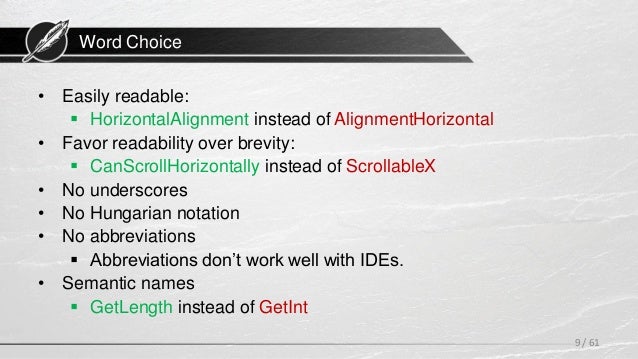Hungarian Notation Struct | As with any plc project, you want your data structures to follow naturally from the actual. Int* pp = static_cast<int*> (q); Hungarian notation is an identifier naming convention in computer programming, in which the name of a variable or function indicates its intention or kind, and in some dialects its type. Hungarian notation considered harmful scope. This chapter is part of the twincat 3 tutorial.
Struct foo { int& x(); If we look at the case for prefixes of variables they are: Most people agree that scope is an interesting information to include as part of the variable name. Installshield help topics employ an extended form of hungarian notation—a naming convention that uses short, lowercase prefixes to indicate the data type. This chapter is part of the twincat 3 tutorial.

Naming conventions are a modern idiom, but names are better than callingvariable a,b.c etc only. Charles simonya, chief architect at microsoft is the originator of the hungarian notation standard, which is used extensively in microsoft windows code. Twincat 3 gives you a lot of options about how to organize the data (whether boolean, integer, floating point, string, or user defined data) in your plc project. The m_ hungarian notation prefix for members is typically not used for structs, even though structs contain members. Typedef struct my_data_struct const* my_data_structcp It allows a programmer to quickly see what type of data is being used in a section of code. Charles simonyi introduced an identifier naming convention that adds a prefix to the identifier name to indicate the. For example, ipointsize denotes an integer variable, while szfilename indicates a string variable. Hungarian notation is an identifier naming convention in computer programming, in which the name of a variable or function indicates its intention or kind, and in some dialects its type. As far as i know, it's not used all that much at msft, although it still shows up quite a bit in windows code; Hungarian notation for c++ hungarian notation is used in naming variables and data types. So nobody read what duoas posted? Most people agree that scope is an interesting information to include as part of the variable name.
Charles simonya, chief architect at microsoft is the originator of the hungarian notation standard, which is used extensively in microsoft windows code. So nobody read what duoas posted? Steve mcconnell's code complete lists some advantages and disadvantages of hungarian. Due to the sheer volume of source code contaminated by this idiom nothing can kill a maintenance engineer faster than a well planned hungarian notation attack. Hungarian notation is the tactical nuclear weapon of source code obfuscation techniques;

When that information is trivially accessible in a modern environment, there's no reason to pay that price. James kanze (gabi software) email:ja*********@gmail.com. If we look at the case for prefixes of variables they are: Typedef struct my_data_struct const* my_data_structcp Naming conventions are a modern idiom, but names are better than callingvariable a,b.c etc only. Most people agree that scope is an interesting information to include as part of the variable name. Where variable names tried to describe themselves for program documentation. Some languages even enforce this as part of the language. Installshield help topics employ an extended form of hungarian notation—a naming convention that uses short, lowercase prefixes to indicate the data type. Struct foo { int& x(); Conseils en informatique orientée objet/. Many commanys have there own ideas, microsoft 10 years or so ago used so called hungarian notation. Consistency is not an advantage in as of itself.
The notation was originally meant to denote the intended usage of a variable rather than its type but it's usually used for type information, particularly for form controls (e.g., txtfirstname for a text box for someone's first name.). For example, ipointsize denotes an integer variable, while szfilename indicates a string variable. Conseils en informatique orientée objet/. So nobody read what duoas posted? My personal opinion is that the best hungarian notation is no hungarian notation.

The m_ hungarian notation prefix for members is typically not used for structs, even though structs contain members. Due to the sheer volume of source code contaminated by this idiom nothing can kill a maintenance engineer faster than a well planned hungarian notation attack. Hungarian notation (hn) is a naming convention invented by charles simonyi from microsoft. Twincat 3 gives you a lot of options about how to organize the data (whether boolean, integer, floating point, string, or user defined data) in your plc project. Charles simonyi is credited with first discussing hungarian notation. My personal opinion is that the best hungarian notation is no hungarian notation. However, using notation to denote the purpose of a variable (that cannot be expressed by its type) is often a good practice. Consequently, labeling them with a m_ prefix is somewhat redundant. The notation was refered to as hungarianoriginally as a criticism. It is a variable naming convention that includes c++ information about the variable in its name (such as data type, whether it is a reference variable or a constant variable, etc). Long, long ago in the early days of dos, microsoft's chief architect dr. Naming conventions are a modern idiom, but names are better than callingvariable a,b.c etc only. Where variable names tried to describe themselves for program documentation.
Installshield help topics employ an extended form of hungarian notation—a naming convention that uses short, lowercase prefixes to indicate the data type hungarian notation. Where variable names tried to describe themselves for program documentation.
Hungarian Notation Struct! However, using notation to denote the purpose of a variable (that cannot be expressed by its type) is often a good practice.
EmoticonEmoticon